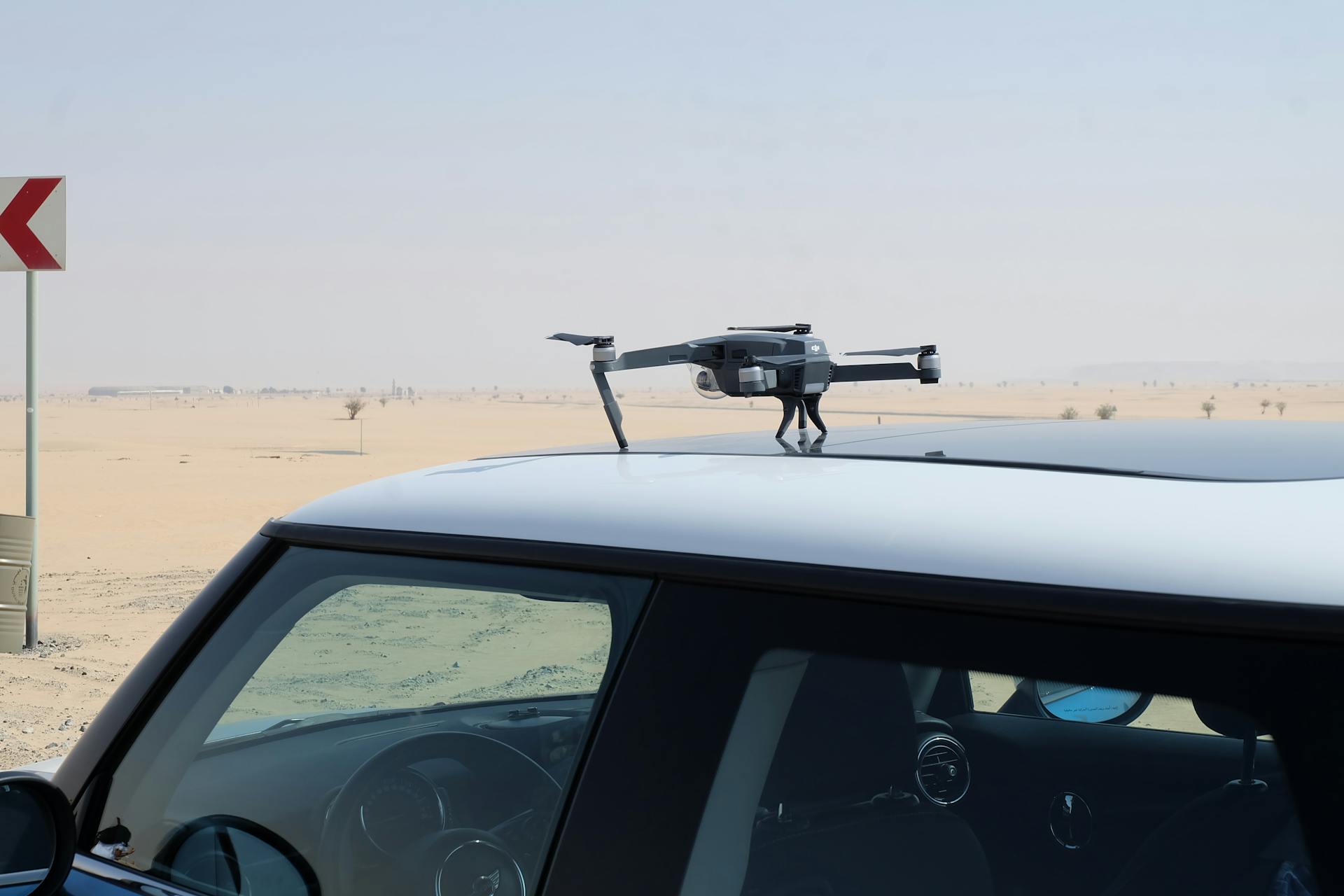
High Altitude Long Endurance UAVs are changing the game in modern use. They can stay aloft for over 24 hours, providing persistent surveillance and communication capabilities.
These UAVs are designed to operate at high altitudes, often above 20,000 feet. This allows them to cover vast areas and gather critical information.
Their long endurance capabilities make them ideal for tasks such as border patrol, search and rescue, and environmental monitoring.
You might enjoy: Long Endurance Uav
High Altitude UAVs
High Altitude UAVs can fly at incredibly high altitudes, with some reaching as high as 96,863 feet, shattering the existing world altitude record for sustained level flight. The Helios prototype, for example, reached this altitude on August 13, 2001.
The RQ-4 Global Hawk HALE UAS can fly at an altitude of 60,000ft, and the Zephyr Stratospheric UAV hovered for more than 25 days during its maiden flight conducted in the third quarter of 2018.
Some High Altitude UAVs have impressive endurance capabilities, with the Yabon Smart Eye UAV able to stay airborne for 120 hours and the MQ-1 Predator UAS able to stay airborne for 40 hours.
Related reading: Uav Flight Planning Software
Helios
Helios was a significant development in high altitude UAVs, building on the lessons learned from the Centurion HALE UAS.
It had a wingspan of 247 feet, much larger than Centurion's 206 feet, and was designed to reach altitudes of 65,000 feet.
The Helios prototype successfully completed low altitude flight testing at Edwards Air Force Base in 1999 under battery power.
In 2001, Helios was equipped with high-efficiency photovoltaic solar cells and reached a record-breaking altitude of 96,863 feet during its second high-altitude flight.
This achievement shattered the existing world altitude record for sustained level flight, previously held by the SR-71A spy plane, which had flown to 85,068 feet in 1976.
The Helios prototype was a precursor to the Global Observer Stratospheric Persistent UAS and demonstrated the viability of stratospheric platform technology for government and commercial applications.
Check this out: UPS Flight Forward
Zephyr Stratospheric
The Zephyr Stratospheric UAV is a remarkable aircraft that has pushed the boundaries of what's possible with high-altitude flight. It hovered for more than 25 days during its maiden flight conducted in the third quarter of 2018.
The Zephyr is a solar-electric, stratospheric UAV offered by Airbus Defence and Space, also referred to as the high altitude pseudo satellite (HAPS). It's an impressive feat of engineering that has the potential to revolutionize the way we think about surveillance and communication.
The Zephyr's ability to stay aloft for extended periods of time is made possible by its solar-electric propulsion system, which harnesses the power of the sun to generate electricity. This allows the aircraft to fly for days on end without the need for traditional fuel sources.
One of the key benefits of the Zephyr is its ability to provide persistent surveillance and communication capabilities from high altitudes. This makes it an attractive option for a range of applications, from military operations to environmental monitoring.
The Zephyr's impressive endurance and altitude capabilities make it a valuable asset in a variety of scenarios. Its ability to stay aloft for weeks at a time and fly at altitudes of up to 25,000ft makes it an ideal platform for a range of applications.
Discover more: List of Unmanned Aerial Vehicle Applications
Design and Features
The REACH-S MALE drone is 5.5m long and has a wingspan of 12m, making it a significant presence in the air. It has a maximum take-off weight of 640kg and a payload capacity of 120kg.
The REACH-S MALE drone can reach an altitude of 19,000ft, while its maximum altitude is 22,000ft. This makes it well-suited for reconnaissance missions.
The United 40 UAV has a wingspan that allows for an ultra-long endurance of 120 hours. Its high aspect ratio wings make it an ideal candidate for long-duration flights.
The REACH-S MALE drone features a reusable design and 24-hour endurance, making it a reliable choice for reconnaissance missions. This design also allows for autonomous take-off and landing capabilities.
The United 40 UAV can carry 1,000kg of payload, including various sensors and communication equipment. This makes it a versatile platform for a range of missions.
The REACH-S MALE drone has a communication range of up to 200km from the ground control station. This makes it well-suited for border security and long-range operational missions.
Readers also liked: Regulation of UAVs in the United Kingdom
Propulsion Details
The REACH-S UAV's propulsion system is powered by a Rotax 912 engine, which produces 73.5kW or 100hp at 5,800 revolutions per minute.
This four-stroke piston engine features four liquid and air-cooled cylinders, making it a reliable choice for high-altitude flights.
The Rotax 912 engine has a displacement of 1,352cm³ and is suitable for use with MON 85, RON 95, and AKI 91 fuel types, giving you flexibility in fuel selection.
The engine's dry sump forced lubrication system ensures that the engine is well-lubricated, even in high-stress conditions.
The Rotax 912 engine's weight is distributed among several components, including an engine mount that weighs 2kg and an air guide hood that weighs 0.4kg.
The engine's exhaust system weighs 4kg, while the external alternator weighs 3kg, showing the importance of careful component selection in UAV design.
The engine's mechanical fuel pump and dual-electronic ignition system ensure a reliable and efficient fuel delivery system, critical for long-endurance flights.
Broaden your view: Micro Air Vehicles
Airbus Defence and Space
Airbus Defence and Space is leading the way with their innovative Zephyr UAV. The Zephyr S is the production model with a 25m wingspan and a weight of less than 75kg. This unmanned aircraft can fly for months continuously.
The Zephyr UAV is equipped with two solar-powered electric motors, allowing it to fly at a maximum altitude of 70,000ft.
Discover more: How High Can a Military Drone Fly
Frequently Asked Questions
Which of the following propulsion systems is more suitable for high altitude long endurance UAV?
Solar power is more suitable for high altitude long endurance UAVs due to its ability to harness energy at high altitudes. This makes it ideal for long-endurance missions and environmental monitoring applications.
How much does the HALE UAV cost?
The MQ-9B HALE UAV costs $3.5 billion for 31 units. This deal marks a significant investment in advanced unmanned aerial capabilities.
Sources
- https://www.avinc.com/innovative-solutions/hale-uas
- https://www.academia.edu/6632990/High_Altitude_Long_Endurance_UAV_Configurations
- https://www.globalsecurity.org/intell/systems/rq-180.htm
- https://www.airforce-technology.com/projects/reach-s-medium-altitude-long-endurance-male-uav-uae/
- https://www.airforce-technology.com/features/featurethe-top-10-longest-range-unmanned-aerial-vehicles-uavs/
Featured Images: pexels.com


